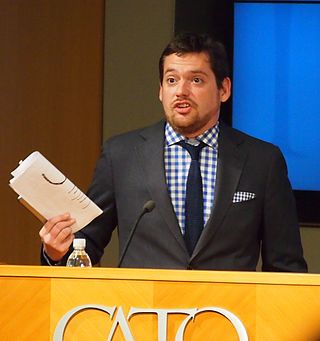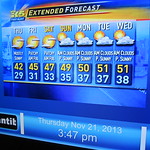
Hypertext is text displayed on a computer display or other electronic devices with references (hyperlinks) to other text that the reader can immediately access. Hypertext documents are interconnected by hyperlinks, which are typically activated by a mouse click, keypress set, or screen touch. Apart from text, the term "hypertext" is also sometimes used to describe tables, images, and other presentational content formats with integrated hyperlinks. Hypertext is one of the key underlying concepts of the World Wide Web, where Web pages are often written in the Hypertext Markup Language (HTML). As implemented on the Web, hypertext enables the easy-to-use publication of information over the Internet.

A blog is an informational website consisting of discrete, often informal diary-style text entries (posts). Posts are typically displayed in reverse chronological order so that the most recent post appears first, at the top of the web page. Until 2009, blogs were often the work of a single individual, occasionally of a small group, and often covered a single subject or topic. In the 2010s, "multi-author blogs" (MABs) emerged, featuring the writing of multiple authors and sometimes professionally edited. MABs from newspapers, other media outlets, universities, think tanks, advocacy groups, and similar institutions account for an increasing quantity of blog traffic. The rise of Twitter and other "microblogging" systems helps integrate MABs and single-author blogs into the news media. Blog can also be used as a verb, meaning to maintain or add content to a blog.

Dan Gillmor is an American technology writer and columnist. He is director of News Co/Lab, an initiative to elevate news literacy and awareness, at Arizona State University's Walter Cronkite School of Journalism and Mass Communication. Dan Gillmor is also in the board of directors of The Signals Network, a non-profit organization supporting whistleblowers.
Social computing is an area of computer science that is concerned with the intersection of social behavior and computational systems. It is based on creating or recreating social conventions and social contexts through the use of software and technology. Thus, blogs, email, instant messaging, social network services, wikis, social bookmarking and other instances of what is often called social software illustrate ideas from social computing.

Electronic literature or digital literature is a genre of literature encompassing works created exclusively on and for digital devices, such as computers, tablets, and mobile phones. A work of electronic literature can be defined as "a construction whose literary aesthetics emerge from computation", "work that could only exist in the space for which it was developed/written/coded—the digital space". This means that these writings cannot be easily printed, or cannot be printed at all, because elements crucial to the text are unable to be carried over onto a printed version.
Blog fiction is an online literary genre that tells a fictional story in the style of a weblog or blog. In the early years of weblogs, blog fictions were described as an exciting new genres creating new opportunities for emerging authors, but were also described as "notorious" in part because they often uneasily tread the line between fiction and hoax. Sometimes blog fictions are republished as print books, and in other cases conventional novels are written in the style of a blog without having been published as an online blog. Blog fiction is a genre of Electronic literature.
An edublog is a blog created for educational purposes. Edublogs archive and support student and teacher learning by facilitating reflection, questioning by self and others, collaboration and by providing contexts for engaging in higher-order thinking. Edublogs proliferated when blogging architecture became more simplified and teachers perceived the instructional potential of blogs as an online resource. The use of blogs has become popular in education institutions including public schools and colleges. Blogs can be useful tools for sharing information and tips among co-workers, providing information for students, or keeping in contact with parents. Common examples include blogs written by or for teachers, blogs maintained for the purpose of classroom instruction, or blogs written about educational policy. Educators who blog are sometimes called edubloggers.

Nick Montfort is a poet and professor of digital media at MIT, where he directs a lab called The Trope Tank. He also holds a part-time position at the University of Bergen where he leads a node on computational narrative systems at the Center for Digital Narrative. Among his publications are seven books of computer-generated literature and six books from the MIT Press, several of which are collaborations. His work also includes digital projects, many of them in the form of short programs. He lives in New York City.

Julian Sanchez is an American writer living in Washington, D.C. Formerly a senior fellow at the Cato Institute, he previously covered technology and privacy issues as the Washington editor for Ars Technica.
John Hawks is a professor of anthropology at the University of Wisconsin–Madison. He also maintains a paleoanthropology blog. Contrary to the common view that cultural evolution has made human biological evolution insignificant, Hawks believes that human evolution has sped up in recent history.

A selfie is a self-portrait photograph, typically taken with a digital camera or smartphone, which may be held in the hand or supported by a selfie stick. Selfies are often shared on social media, via social networking services such as Facebook, Instagram, Threads, Twitter, and Snapchat.

Multimodality is the application of multiple literacies within one medium. Multiple literacies or "modes" contribute to an audience's understanding of a composition. Everything from the placement of images to the organization of the content to the method of delivery creates meaning. This is the result of a shift from isolated text being relied on as the primary source of communication, to the image being utilized more frequently in the digital age. Multimodality describes communication practices in terms of the textual, aural, linguistic, spatial, and visual resources used to compose messages.
Scott Rettberg is an American digital artist and scholar of electronic literature based in Bergen, Norway. He is the co-founder and served as the first executive director of the Electronic Literature Organization. He leads the Center for Digital Narrative, a Norwegian Centre of Research Excellence from 2023 to 2033.
Lilie Chouliaraki is a professor in Media and Communications at the London School of Economics and Political Sciences (LSE). Chouliaraki’s main area of research is the mediation of human vulnerability and suffering. She empirically explores how the media affects our moral and political relationships with distant others in the sense that it affects how we see the vulnerability of other people and how we are asked to feel, think and act toward them.
David Jhave Johnston is a Canadian poet, videographer, and motion graphics artist working chiefly in digital and computational media,. and a researcher at the Center for Digital Narrative at the University of Bergen. This artist's work is often attributed, simply, to the name Jhave.

Sivilisasjonens venterom was a research larp held in Bergen in November 2021. It was designed to explore the potential of larps as a research methodology and as research dissemination, and was specifically intended to investigate ethical questions that arise when encountering new surveillance technologies.
In the digital humanities, "algorithmic culture" is part of an emerging synthesis of rigorous software algorithm driven design that couples software, highly structured data driven design with human oriented sociocultural attributes. An early occurrence of the term is found in Alexander R. Galloway classic Gaming: Essays on Algorithmic Culture
Online Caroline was a web soap opera in 24 episodes written and published online by Tim Wright, Rob Bevan and Tom Harvey at the production company XPT in 2000. It was "an instant hit" and won that year's British Academy of Film and Television Arts award in the interactive category.









